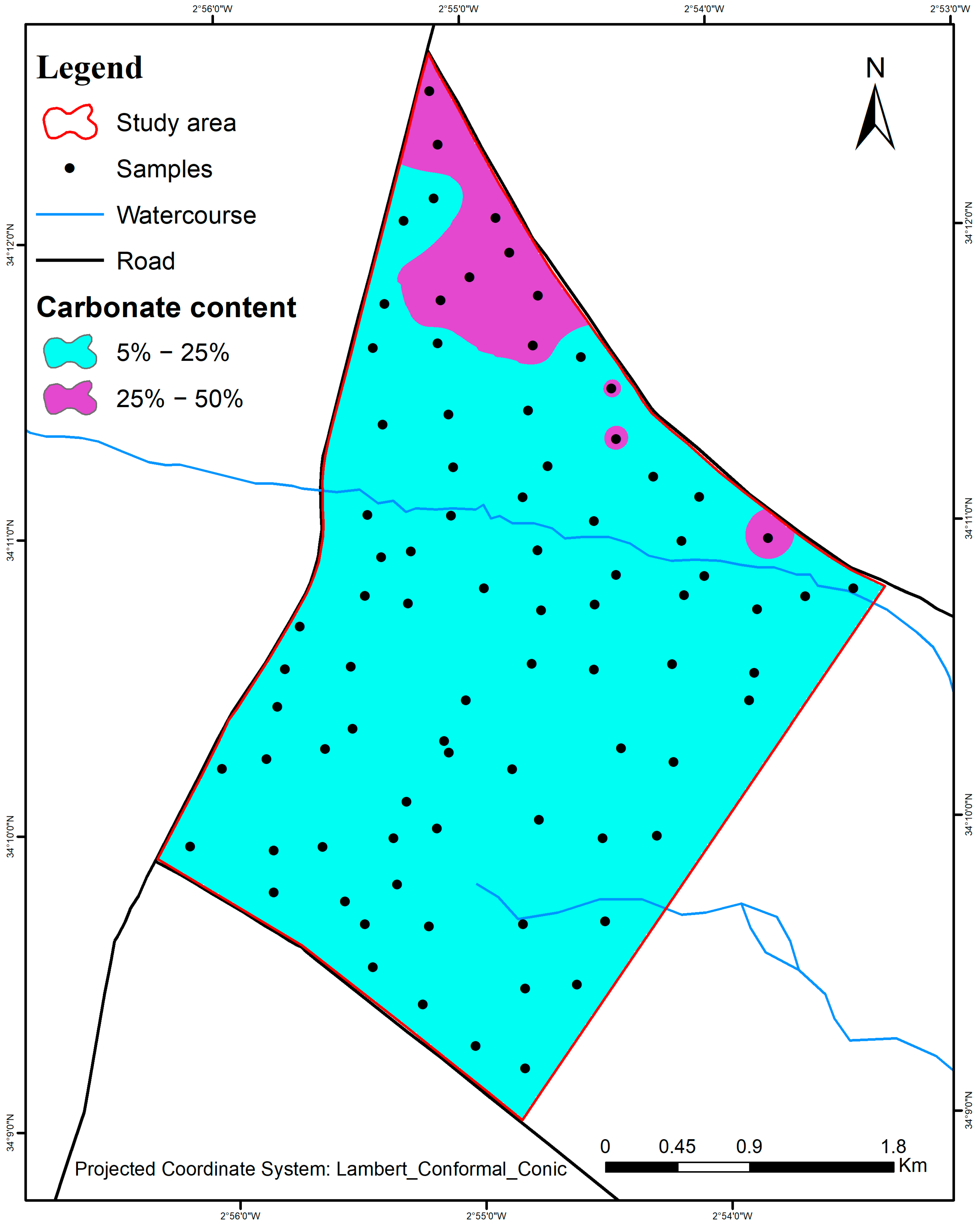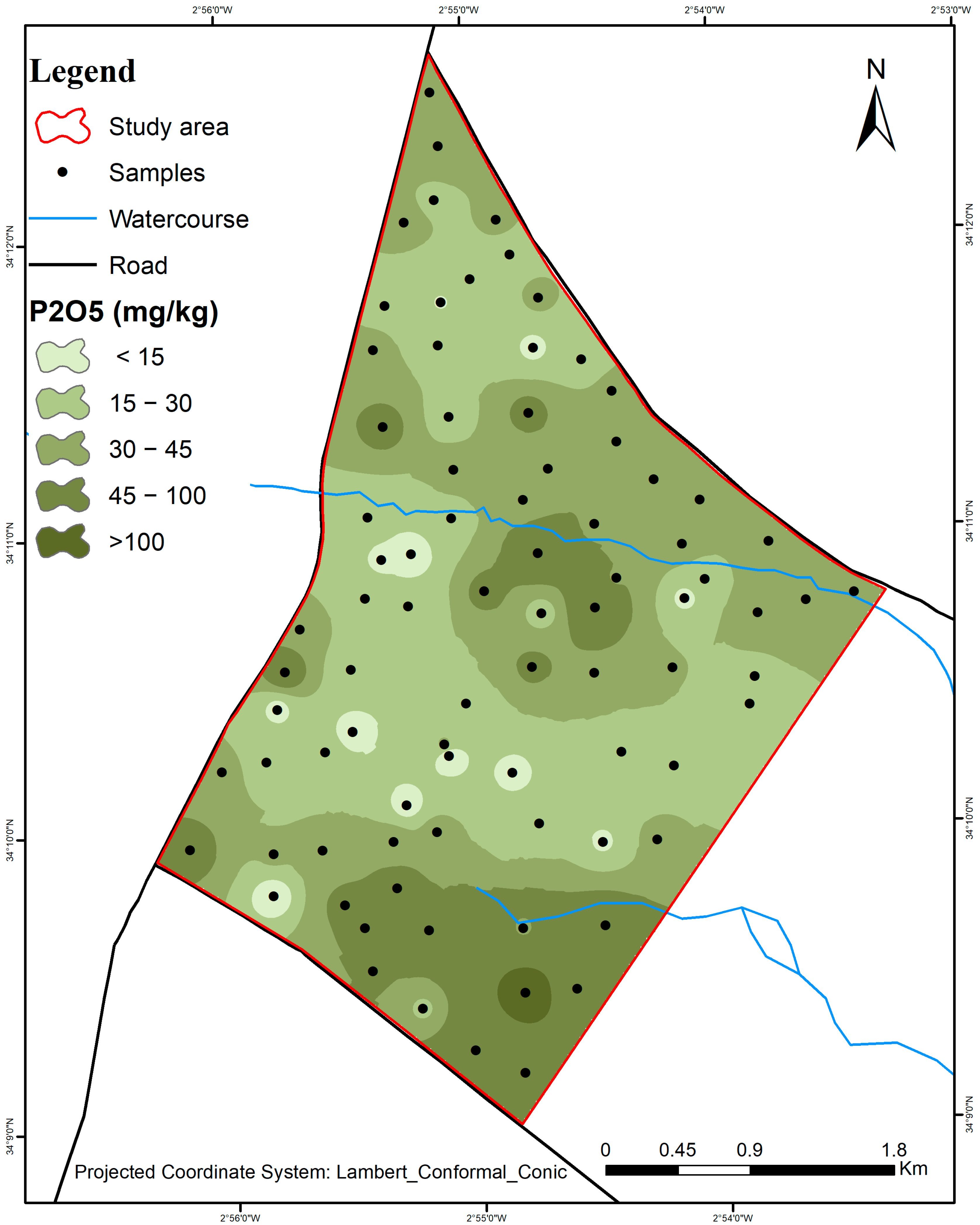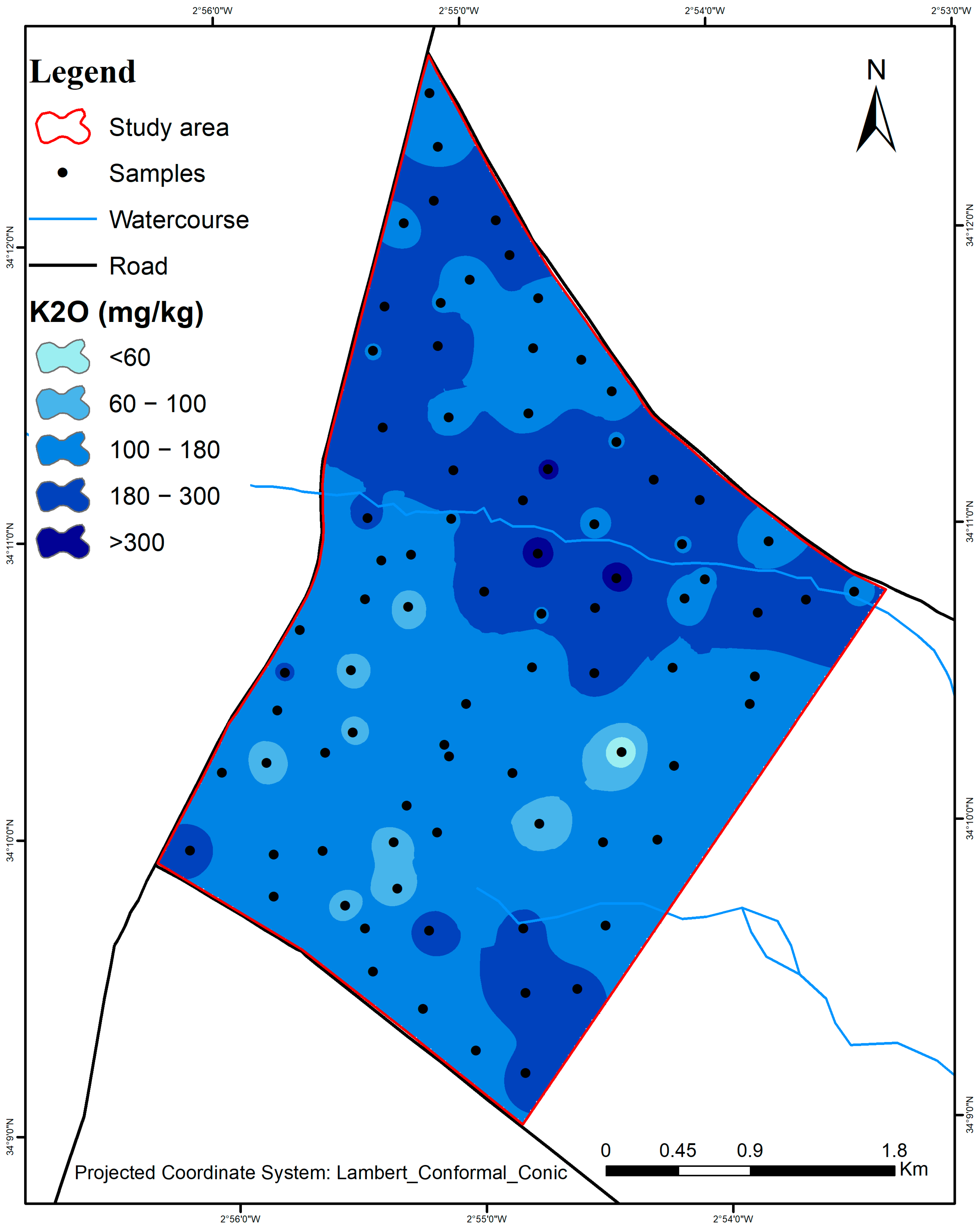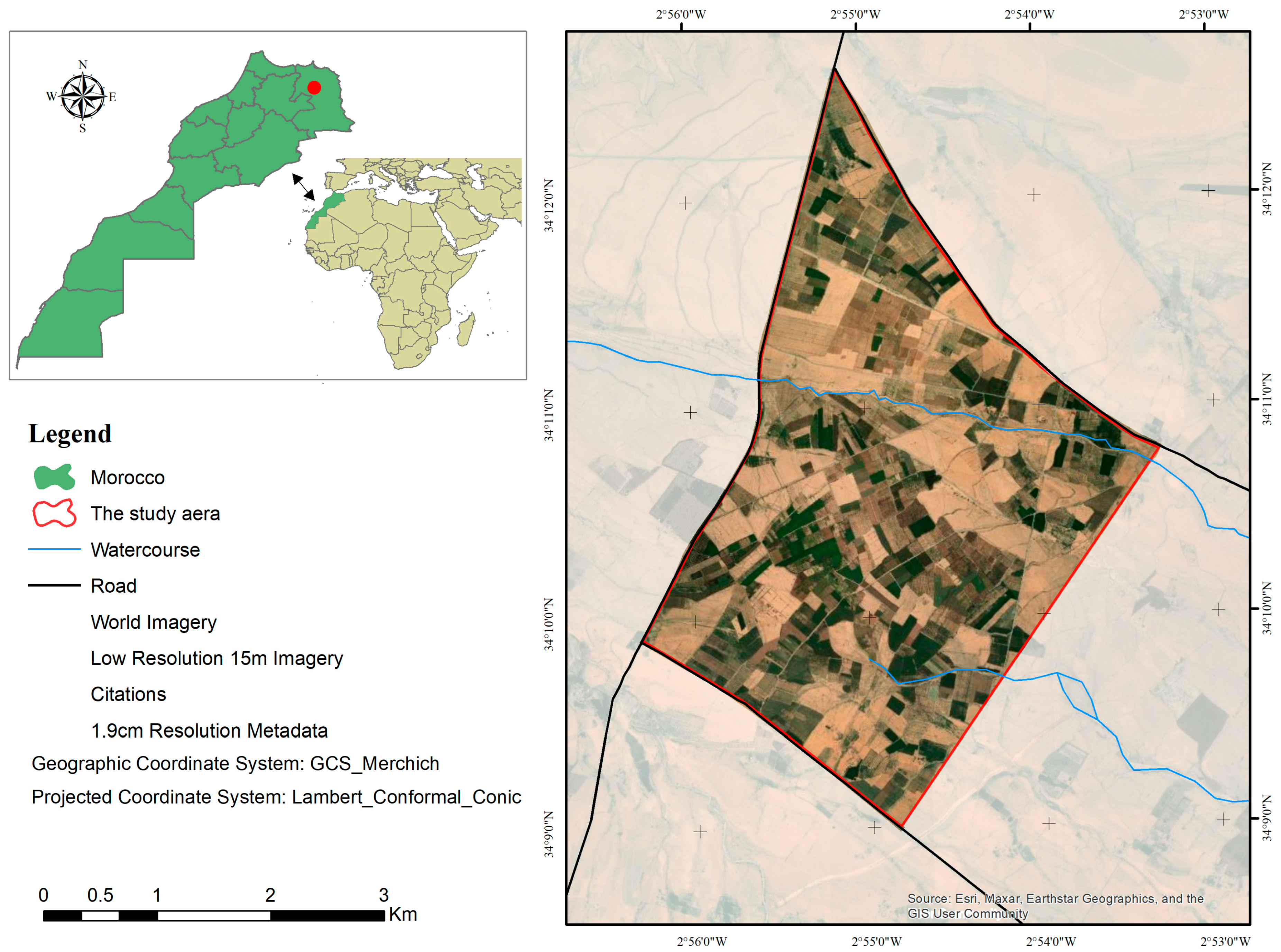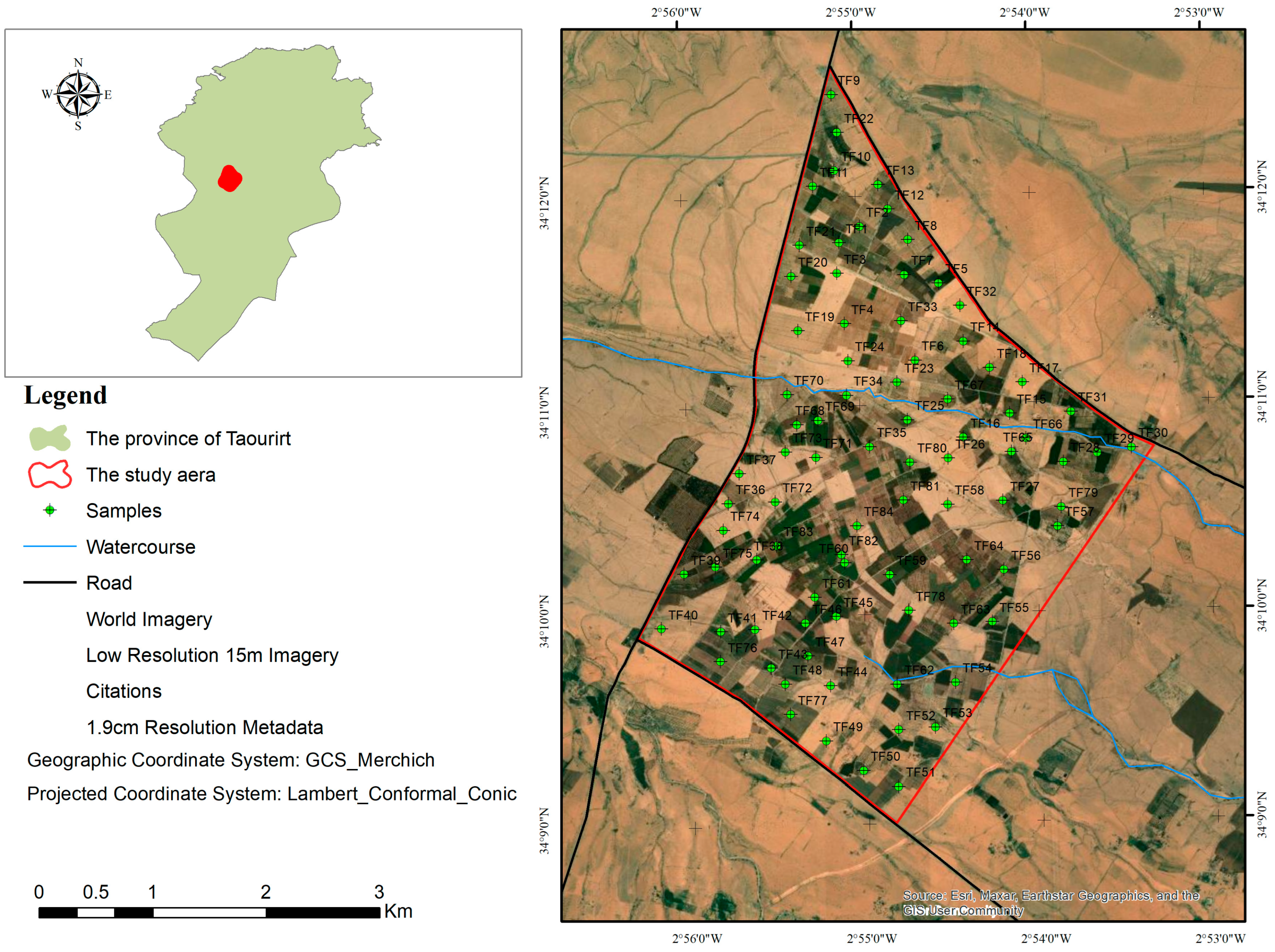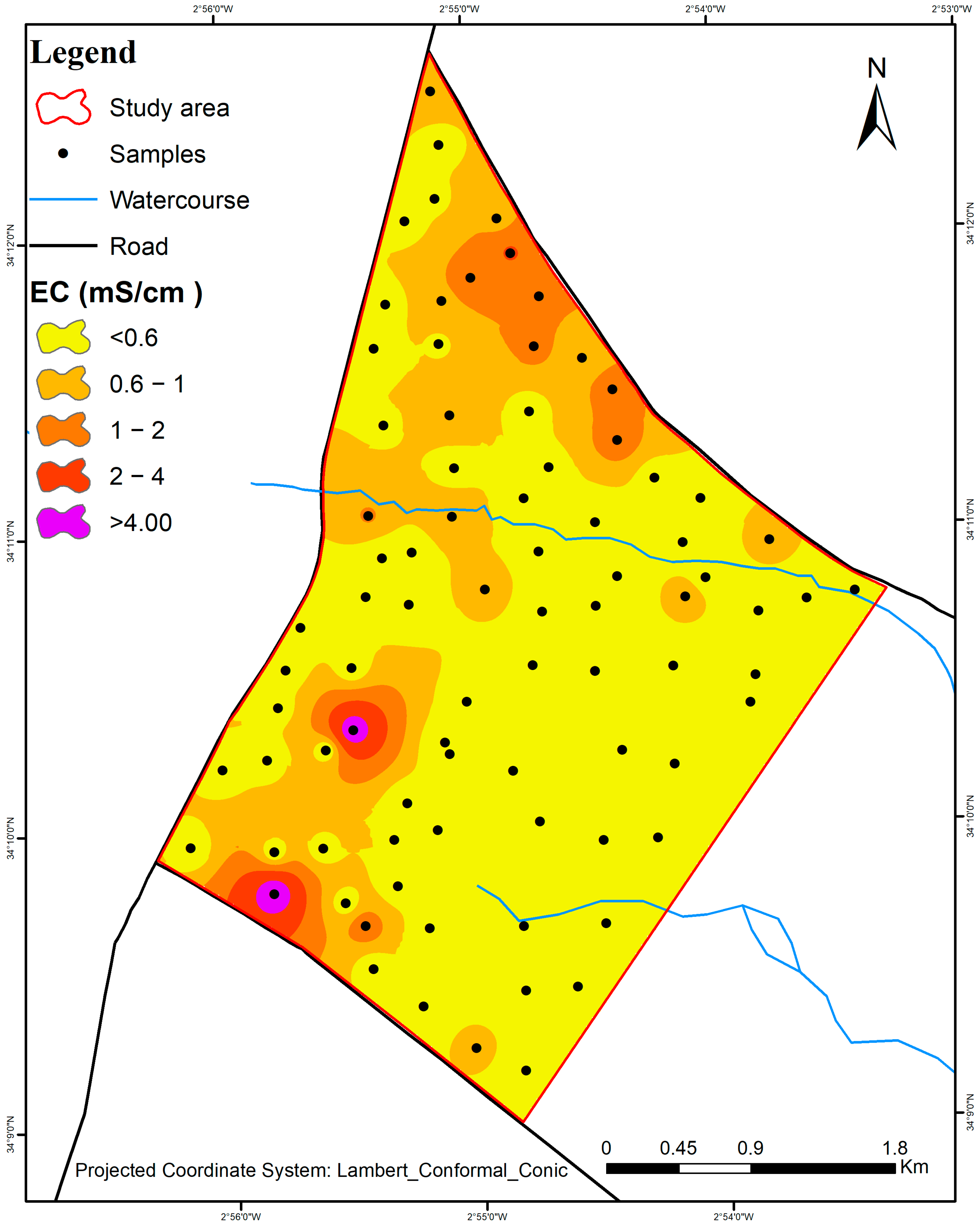1. Introduction
Soil health and fertility are fundamental to sustainable agricultural systems, as they directly impact crop productivity and resource conservation. In arid and semi-arid regions, where water is scarce and soil resources are vulnerable, maintaining soil quality is particularly challenging. Approximately 60% of such regions globally are located in lower-income nations, where agricultural production heavily relies on rainfall [
1]. Morocco exemplifies this reality, with about 85% of its agricultural land depending on rainfall for irrigation. However, irrigation is crucial to Morocco’s economy and food security. Of the 8.7 million hectares of arable land, approximately 1.2 million hectares are irrigated, representing about 14% of the total arable land [
2]. Irrigated agriculture contributes, on average, about 45% of the country’s agricultural value added, while the agricultural sector itself represents between 13% and 20% of the national GDP [
3]. Agriculture also remains Morocco’s largest employment sector, underscoring its social and economic significance.
Despite its essential role, Morocco’s irrigated areas face significant challenges due to excessive exploitation and various forms of degradation [
4]. Studies show that intensive irrigation without sustainable practices can lead to soil degradation, as demonstrated by research across Morocco [
5,
6,
7,
8,
9,
10]. Factors such as climate, agronomic practices, soil texture, low organic matter, and the quality of irrigation water and drainage conditions are major contributors to this degradation [
11,
12].
This situation highlights the importance of continuous monitoring of soil and water resources in irrigated perimeters to assess degradation levels, estimate problem severity, and provide timely data for guiding sustainable practices [
13]. Based on field investigations in the TIP, several issues have been identified that significantly affect soil quality and sustainability. Intensive agriculture, characterized by the irrational use of synthetic fertilizers and pesticides, has led to soil degradation and fertility loss. Moreover, the predominant use of traditional gravity-based irrigation systems, which are less efficient in water management, further exacerbates resource wastage. To address these challenges, the adoption of localized irrigation techniques could significantly improve water efficiency and help mitigate these negative impacts [
14]. The semi-arid climatic conditions of the region aggravate these issues by intensifying evapotranspiration, thereby increasing the risks of abiotic stress. These combined factors contribute to declining soil quality, reduced agricultural productivity, and lower crop yields, posing a threat to food security in the face of growing climate change challenges.
This study, conducted for the first time in the TIP, focuses on understanding and addressing these challenges. It examines TIP’s soil properties to evaluate their physico-chemical characteristics and identify suitable management strategies. The region, located in Taourirt province, relies on seasonal rainfall from the Oued Za dam for irrigation. In this semi-arid environment, promoting sustainable agricultural practices is crucial to preserving resources for long-term viability [
5].
This study aims to analyze TIP’s soil properties to understand its physico-chemical characteristics and identify suitable management strategies. Key parameters, including particle size, soil bulk density, pH, electrical conductivity, organic matter, and nutrient levels, were measured to assess soil quality. Data collected will be analyzed using Geographic Information System (GIS) to create thematic maps illustrating spatial variations across the TIP. This approach not only enhances the understanding of soil health but also informs decision making for soil and water management.
It is hypothesized that intensive agricultural practices, coupled with the absence of sustainable management models, have caused significant spatial variability in soil quality within the TIP. Factors such as low organic matter and nutrient imbalances may be worsening soil degradation and reducing water retention. This study will test whether GIS can provide insights into these variations and help develop strategies to mitigate risks and ensure long-term agricultural sustainability.
Ultimately, this research seeks to offer data-driven recommendations for sustainable soil management in the TIP, contributing to enhanced agricultural productivity, economic growth and environmental conservation, with potential applications for other arid regions in Morocco.
4. Discussion
Soil texture: Soil texture directly influences the soil–water relationship, aeration, and root penetration. It also plays a key role in determining the soil’s nutritional status. The dominant soil texture (sandy loam) is characterized by a predominance of sand-sized particles (0.05–2.0 mm diameter). These soils exhibit good drainage characteristics, moderate to high hydraulic conductivity, and provide optimal conditions for root development and proliferation. However, they also present specific challenges related to moisture retention and nutrient availability [
38]. Importantly, the TIP is a recently established irrigated plain, created in 2013. In contrast, the Triffa Plain (TP) is a well-established agricultural area located approximately 100 km away, sharing similar soil characteristics and farming systems. According to [
5], soils in the TP are also predominantly sandy loam, which confirms the pedological similarity between the two plains. Moreover, Fetouani et al. (2007) [
39] highlighted the environmental vulnerability of these sandy soils under intensive irrigation: their study found that 73% of sampled groundwater in the TP exceeded the WHO standard of 50 mg·L
−1 for nitrate (NO
3-N), and over 71% of the samples were classified as “bad” or “very bad” in terms of water quality. Given the similarities in soil texture, irrigation practices, and agricultural intensification between the TIP and TP, it is crucial to draw lessons from the Triffa experience. Without proper management, the TIP may face comparable risks of nutrient leaching and groundwater contamination. These findings underscore the urgent need for proactive soil and irrigation management strategies in the TIP to prevent environmental degradation and ensure long-term sustainability. As also shown by [
40], sandy loam soils require site-specific management such as precision fertilization, organic matter enrichment, and controlled irrigation to optimize productivity and minimize environmental risks. As well, the addition of clay can help increase yields [
41] and limit nutrient leaching [
42], making it an effective strategy for improving the performance of light-textured soils.
Bulk density: Soil compaction, as observed in the area, leads to significant changes in the physical and chemical properties of the soil, as well as alterations to the root system structure. These changes can severely limit nutrient uptake by plants and negatively impact the surrounding ecosystem. Specifically, in compacted soils, nitrogen losses to groundwater and the atmosphere are often higher compared to non-compacted soils [
43]. The compression of pores between and within aggregates reduces aeration and water infiltration, increases soil resistance, and disrupts the functioning of soil pores, ultimately hindering root development. This increased compaction can also enhance horizontal water flow, raising the risk of soil erosion [
44]. The observed porosity values align with previous findings by [
45], indicating that similar trends occur in comparable soil conditions. To mitigate these effects and move toward sustainable land use, it is crucial to implement soil conservation strategies that address compaction at both structural and operational levels. Practices such as controlled traffic farming, deep tillage, organic matter incorporation, and cover cropping can significantly improve soil structure, restore porosity, and enhance biological activity. Integrating these techniques within a broader sustainable agricultural management framework not only improves crop resilience and yields but also preserves the ecological functions of the soil. In the context of the TIP, where newly developed irrigated lands are vulnerable to degradation, promoting such practices is essential to ensure long-term soil health and sustainable agricultural production.
Electrical conductivity: According to the guidelines established by [
33] and later referenced by [
46], 77% of the plots are classified as non-saline, 11% as slightly saline, 8% as saline, and the remaining plots fall between the “very saline” and “extremely saline” categories (
Table 2). The results indicated that, in more than 76% of the plots, covering an area of 924.46 ha, salinity had a negligible effect on plant growth. However, for 12% of the plots, salinity levels could affect very sensitive crops, and for 8% of the plots, salinity could substantially reduce the quantity and quality of most crops. For the remaining soils, only salt-tolerant crops can be grown [
47]. This relatively low salinity in the soils can be attributed to continuous surface irrigation throughout the year for intensive agricultural production, as well as the good drainage capacity of soils. Both factors contribute to the continuous leaching of salts from the superficial soil layer (0–30 cm), where plant roots develop.
On the other hand, high electrical conductivity values ranging from 4 to 5.57 mS/cm were observed at stations TF76 and TF83. These localized salinity peaks are not attributed to saline irrigation water but are more likely linked to the nature of the parent material or excessive mineralization in certain soil layers. In semi-arid environments such as the TIP, the use of drip irrigation during the summer period, although efficient in terms of water use, can inadvertently lead to salt accumulation in the rhizosphere, especially when the irrigation flow rate is very low and leaching practices are insufficient. Salt stress is recognized as one of the most critical forms of soil degradation globally, as it severely limits both crop productivity and soil biological activity [
48]. Without appropriate mitigation strategies, salinization may progressively render soils agriculturally marginal or even unproductive.
This situation underlines the urgent need for a comprehensive and sustainable soil management strategy tailored to the saline-prone areas of the TIP. As highlighted by Salvadora et al. (2023) [
49], several nature-based and agronomic solutions have proven effective for the reclamation of saline and degraded soils in Mediterranean and semi-arid climates. These include phytoremediation, phytodesalination, vegetative bioremediation, the application of soil amendments (e.g., gypsum, compost), the use of Technosols, and the inoculation of beneficial microorganisms, such as plant growth-promoting bacteria and arbuscular mycorrhizal fungi, which enhance plant tolerance to salt stress and improve nutrient uptake.
pH: Soil pH in the TIP area is not currently a limiting factor for crop production, as 76% of the studied area is classified as weakly basic, while the remaining portion is neutral, and the relatively low R
2 values can be explained by the wide classification intervals adopted in this study (
Table 3), where each class spans at least 0.5 units. In contrast, the RMSE and MAE values remained below 0.2, indicating limited absolute prediction errors. This outcome is consistent with our methodological approach, as the interpolation was not designed to achieve exact point predictions but rather to classify soils within standard pedological ranges. Given that these intervals are relatively broad, the predicted values generally fall within the correct soil category, even if the statistical indicators suggest modest predictive performance. Such reasoning applies not only to pH but also to all soil parameters evaluated in the present study.
This distribution is typical for soils in semi-arid regions, where the presence of basic parent materials and the accumulation of carbonates are the primary factors responsible for soil alkalinity. The limited leaching under low rainfall conditions also contributes by allowing these alkaline compounds to persist and accumulate in the soil profile. Soil pH plays a fundamental role in nutrient availability, microbial activity, and overall soil fertility. In calcareous soils, as found in TIP, alkalinity is largely explained by the interaction between calcium carbonate (CaCO
3) and the clay–humus complex (CHC). When calcium ions (Ca
2+) are released, they are exchanged with hydrogen ions (H
+), which then react with hydroxide ions (OH
−) to form water (H
2O), thereby neutralizing potential acidity and stabilizing the pH [
5]. While this natural buffering confers stability on the system, it does not exclude future risks of acidification. Unsustainable fertilization practices, particularly the repeated use of ammonium-based fertilizers, can induce soil acidification over time. The nitrification of ammonium (NH
4+) releases hydrogen ions (H
+), which lower pH, especially when nitrate leaching exceeds plant uptake, a common scenario in over-fertilized or poorly managed systems [
50]. In addition, intense summer rainfall events, often observed in semi-arid climates, may promote surface runoff that preferentially removes base cations (Ca
2+, Mg
2+, K
+), leaving acidic protons behind. Optimal pH ranges for crop production typically lie between 6.5 and 7.5 in non-calcareous soils and between 7.9 and 8.5 in calcareous systems [
51]. However, high pH levels can reduce the availability of micronutrients such as Fe, Mn, Zn, and Cu [
52] and may also impact soil infiltration and water movement due to changes in clay dispersion and aggregation [
53]. Maintaining the current pH balance will require sustainable nutrient management, as mentioned by [
54,
55].
Total carbonate content: In the studied plots, carbonate precipitations are observed under the tree canopy, often appearing as whitish efflorescences. This preferential accumulation beneath trees, as opposed to inter-tree or bare areas, can be attributed to localized leaching effects induced by irrigation, which displace carbonates from the surrounding soil and concentrate them in areas of reduced evaporation. The carbonate content in inter-row zones is also influenced by the region’s semi-arid climate, which promotes limited leaching and facilitates carbonate persistence.
Field observations using hydrochloric acid (HCl) revealed visible effervescence in several bare areas, confirming the presence of carbonates beyond just calcium carbonate, potentially including other forms such as magnesium carbonates or dolomitic components. These findings are consistent with the regional pedogenesis, as the soils across the study area are derived from carbonate-rich parent materials, as noted in [
15]. Calcareous soils pose significant agronomic challenges due to their high carbonate content, which can limit the availability of micronutrients (such as iron, zinc, and manganese), increase the risk of soil compaction, and reduce water retention capacity. To cope with these constraints, local farmers often choose tolerant species, such as fig trees, which are better adapted to such edaphic conditions. However, long-term sustainability in such systems requires more than crop selection. As part of a sustainable agricultural management strategy, interventions such as clay amendment incorporation, organic matter enrichment, and microbial inoculation can enhance soil structure, nutrient availability, and water-holding capacity. For example, studies conducted in arid regions by [
56] have shown that applying clay-rich layers to sandy calcareous soils improves root distribution, increases soil water content, and reduces salinity. Promoting these practices at the local level is essential to improve the resilience and productivity of calcareous soils under increasing climatic and agronomic pressures.
Available phosphorus: The spatial variability of available phosphorus (AP) in the TIP area reflects differences in fertilization practices among farmers, particularly in the use of NPK fertilizers whether in conventional or soluble forms applied in combination with localized irrigation systems. Phosphorus plays a critical role in early plant development, especially in root formation, which enhances the plant’s ability to access water and nutrients during sensitive growth stages [
57]. Higher phosphorus concentrations were observed in intensively cultivated plots, likely due to over-application of phosphate fertilizers. Soil moisture, particularly in areas near the valley, facilitates the diffusion of phosphorus toward the root zone, promoting uptake. This correlation between moist zones and higher phosphorus availability is evident in the spatial maps. In contrast, low phosphorus levels were recorded in fallow, uncultivated, or virgin plots, where the absence of fertilizer input and the natural leaching and erosion processes contribute to phosphorus depletion. Globally, phosphorus in natural soils originates solely from parent material weathering, making it a naturally limited and non-renewable resource [
58].
Field observations also revealed considerable variation in farmers’ education levels, ranging from university-trained individuals to those with no formal education. This disparity contributes to inconsistent and sometimes unsustainable fertilizer application practices. In this context, it is crucial that agricultural policymakers and extension services strengthen on-site farmer training, focusing on the 4R nutrient stewardship principles. Raising awareness about the long-term environmental risks of phosphorus overuse, such as eutrophication of nearby rivers and groundwater contamination, is particularly important in the TIP region, which is characterized by sandy soils with low phosphorus retention capacity. As highlighted by [
54], sustainable phosphorus management must be tailored to local socio-economic and agro-environmental contexts, especially in areas where land is privately owned by smallholder farmers. Empowering these landowners to adopt sustainable agricultural strategies—including precision fertilization, soil testing, and organic alternatives will be key to enhancing long-term soil fertility while protecting surrounding ecosystems.
Exchangeable potassium: The spatial distribution of exchangeable potassium (EP) in the TIP area reflects similar patterns to those observed for available phosphorus, as most farmers in the region apply NPK compound fertilizers, often without prior soil analysis. In fact, recent field data show that over 70% of farmers do not follow specific fertilizer recommendations [
5], leading to an excessive accumulation of potassium in cultivated zones, particularly under fruit trees and near irrigation points. This practice is commonly driven by the perceived need to compensate for low potassium availability, often associated with the presence of calcareous soils, where calcium-rich environments reduce potassium uptake efficiency. While potassium is essential for plant resilience, supporting rapid growth, stomatal regulation, and resistance to pests and drought stress [
59], over-application poses significant environmental risks. Excess potassium may accumulate in the soil profile and, through percolation or surface runoff, contribute to groundwater pollution. Moreover, it can disturb nutrient balance by antagonizing magnesium uptake, potentially leading to secondary magnesium deficiencies in crops.
Given the similarity between the spatial patterns of phosphorus and potassium, as confirmed by thematic maps, it is evident that these nutrients are being applied in tandem via NPK fertilizers, often without alignment to actual crops or soil needs. Therefore, it is essential to adopt the same sustainable agricultural management strategies previously mentioned for phosphorus. Adopting these strategies will be crucial to maintaining long-term soil fertility while minimizing the risk of nutrient leaching and groundwater contamination, especially in the TIP’s sandy and weakly structured soils. The integration of agronomic best practices with environmental stewardship will ensure that productivity gains do not come at the expense of ecological sustainability.
Organic Matter: In the semi-arid agroecosystem, low levels of soil organic matter (OM) are a common characteristic, largely influenced by the region’s limited rainfall, high evapotranspiration, and reduced microbial activity under dry conditions [
60]. This situation is further exacerbated by the dominance of sandy loam soils, which inherently possess low water and nutrient retention capacities, accelerating the mineralization and leaching of organic compounds [
45]. In several plots, excessive irrigation, especially in the absence of adequate soil cover, has contributed to downward drainage and loss of soluble organic fractions, ultimately diminishing soil fertility. From a long-term soil health perspective, persistently low OM levels of 1.46% pose several concerns. Reduced OM diminishes soil structure, lowers water-holding capacity, and weakens nutrient retention, collectively increasing vulnerability to erosion, compaction, and further fertility decline. Over time, such soils are less resilient to climatic stressors, including drought and heatwaves, and may experience declining crop yields, heightened reliance on chemical fertilizers, and reduced ecosystem service provision.
The measured OM levels in our study confirm this trend, with many fields falling into the “moderately poor soil” category. These findings are consistent with previous research conducted in a nearby, more established irrigated plain within the same region, where OM values ranged from 1.12% to 3.30% [
61]. The relatively higher OM levels observed in certain fields within TIP are likely the result of localized applications of organic amendments, such as manure or compost [
62], which remain limited and inconsistent across the perimeter. Although we did not directly measure total OM, it was estimated based on organic carbon values obtained via the Walkley & Black method, using the standard conversion factor of 1.72. This approach, while widely accepted, may slightly underestimate total organic matter in certain soil types with high charcoal or resistant fractions. Nevertheless, the results provide a reliable basis for spatial assessment and management recommendations.
From a sustainable agricultural management perspective, addressing organic matter deficiency is a priority action to restore soil structure, improve water holding capacity, and enhance nutrient cycling. Improving organic matter levels not only contributes to soil resilience under semi-arid stressors but also enhances long-term agricultural productivity and environmental sustainability objectives that are central to the Green Generation 2020–2030 vision.
